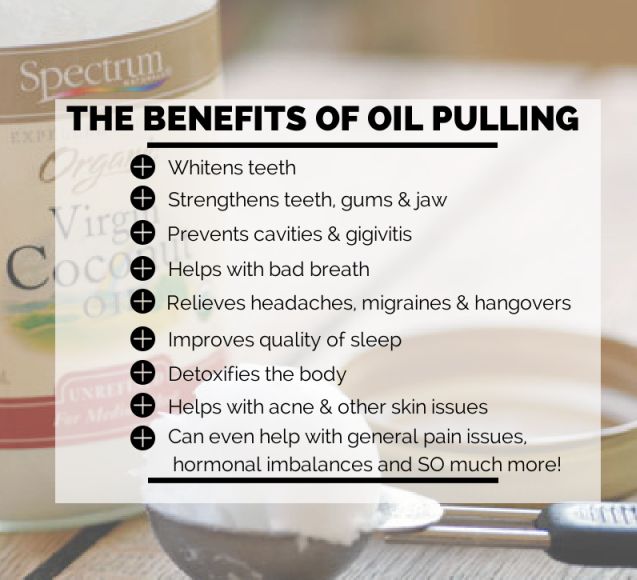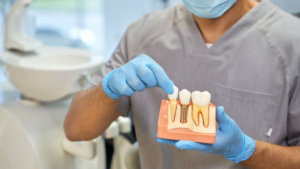There is currently a lot of information online and in health magazines about the oral health benefits of “oil pulling”.
“Oil pulling” involves swishing your mouth out with some type of edible oil (usually coconut or sesame oil).
The technique is similar to how you would ordinarily use mouthwash; however with oil pulling it’s recommended that you swish the oil in your mouth for up to 5 to 20 minutes.
Seems like a lot of time and effort, doesn’t it?
Proponents of oil pulling claim that it has the following benefits to your oral health:
- Oil pulling can prevent tooth decay and cavities.
- It can fight gingivitis (help look after your gums).
- It can whiten your teeth.
- It can reduce bad breath.

Naturally, big claims require big evidence, so let’s take a look at how far we can actually say that oil pulling can have any of these oral health benefits.
1) Oil pulling can prevent cavities.
Those who say that that oil pulling can help prevent cavities and tooth decay claim that the oil can kill the harmful plaque bacteria that cause these problems.
There actually have been a couple of clinical studies on this.
Both studies suggested that oil pulling can reduce the amount of harmful bacteria in someone’s mouth, and that the extent to which it can do this is similar to regular mouthwash.
Both of the studies claim that the active, anti-bacterial ingredient in the oils is lauric acid.
The oil with the highest quantities of lauric acid is coconut oil.
Therefore coconut oil is the best oil to use for oil pulling, as far as preventing tooth decay is concerned.
Despite this, it is also very important to remember that the mechanical removal of bacteria is far more effective than trying to kill the bacteria with chemicals.
This means that brushing is far more important in preventing tooth decay and cavities than any type of mouthwash (oil or otherwise) will ever be.
Dentist’s verdict: Oil pulling can complement daily brushing to help prevent tooth decay, but it certainly is not essential and definitely should not be seen as the most important factor in preventing cavities. If you are to use oil pulling for this purpose, you should use coconut oil as it has high concentrations of lauric acid, which is the ingredient that actually reduces the amount of harmful bacteria in your mouth.
2) Oil pulling can fight gingivitis and protect you from gum disease.

This is supported by the same theory that underlies the claim that oil pulling can help fight against tooth decay.
Proponents of oil pulling argue that when you swish your mouth out with oil, it can get underneath your gum line and reduce the amount of inflammation-causing bacteria in contact with your gums.
Again, there are a very small number of clinical studies supporting this.
The active ingredient in the oil with regards to fighting gingivitis is, again, lauric acid.
Therefore, the best oil to use for oil pulling (as far as looking after your gums is concerned) is coconut oil.
Once more, it is important to stress that the bacteria that causes gum inflammation is far less resistant to mechanical, rather than chemical cleaning.
Therefore oil pulling should not be seen as an alternative to flossing, rather it should complement regular flossing.
Additionally, if you have symptoms of gum disease such as receding gums, or gums that regularly bleed during brushing, it is best to see a dentist or periodontist about this.
Dentist’s verdict: Oil pulling with coconut oil can help with more mild forms of gingivitis when used in conjunction with flossing. This is (again) due to the lauric acid in coconut oil. It should not be seen as a way of treating more serious gum disease or as a replacement of flossing.
3) Oil pulling can whiten your teeth.
Most of the “evidence” for the ability of oil pulling to whiten your teeth comes from “before and after” shots of people’s teeth along with the claim that these results were achieved by oil pulling.

The above photo is an example of this.
Please note that the video that this comes from is trying to sell oil pulling products…so make of that what you will.
The best way to measure how far oil pulling can whiten your teeth is through clinically controlled studies comparing the changes in tooth shade of a group of people who do oil pulling against a group of people who do not.
All other variables that may affect tooth shade, such as what people eat and drink, their other oral hygiene habits, and even how they breathe when asleep, need to be controlled.
Currently, no such clinical study exists, so we will have to make do with evaluating the mechanism to which oil pulling can (apparently) whiten your teeth.
Tooth stains can be broadly categorised into three groups:
1) Extrinsic stains: these are stains to the outer surface of your tooth (enamel) usually caused by certain foods, drinks and smoking.
2) Intrinsic stains: these are stains of the dentin, a tissue which lies below the enamel. This is usually caused by trauma.
3) Age related stains: as you age enamel thins and dentin naturally darkens, the combination of this leads to darkened teeth as you get older.
Now as oil pulling involves bathing the outer layer of your teeth in oil, it could only possibly fight extrinsic staining.
The only possible way that oil pulling can lift these stains is if the stains are “fat-soluble”.
If this is the case, then extended contact with oil may dissolve some of the stains off your teeth.
So is there any evidence that extrinsic tooth stains are “fat-soluble”?
Well let’s use the example of three common substances that cause extrinsic tooth staining: red wine, coffee and tobacco.
In coffee and wine, the staining substance is tannin. Tannin is water-soluble, rather than fat soluble.
Tobacco smoke stains the teeth due to the nicotine in it (nicotine can also stain your fingers in a similar way).
Nicotine stains are soluble in strong acids (such as carbamide peroxide tooth whitening gels) and alcohols, but not in fat.
Quite simply, if you had these types of stains on another type of material (such as clothes or carpet) you would not use oil to get them out.
No, rather you would simply scrub the stain with some sort of abrasive material (such as a sponge).
This, with enough persistence, will remove some of the stains.
Covering the stain with oil, and applying little to no pressure, will do nothing.
Teeth are exactly the same, which is why oil pulling will unlikely do much to remove even extrinsic stains.
Rather, the “tooth” equivalent of scrubbing (brushing, and scaling and polishing by a hygienist) will help remove these stains.
Dentist’s verdict: oil pulling will not whiten your teeth by itself, and any effects compared to good brushing and scaling and polishing will be minimal.
4) Oil pulling can reduce bad breath.
To say that one thing will “reduce bad breath” is always going to be somewhat misleading as bad breath can have many causes.
Therefore the best way to prevent bad breath is dependent on what the cause of your particular bad breath is.
Therefore the effective way to fight bad breath could be: a change in your diet, to start flossing, or to stop smoking.
One of the most common causes of bad breath is gingivitis and gum disease.
This type of bad breath has a very distinctive smell.
If you floss, and then smell the stuff that comes out onto your piece of floss, that is what bad breath due to gum disease smells like.
Oil pulling can help prevent this particular cause of bad breath as the lauric acid in coconut oil can kill the bacteria which causes gum inflammation.
Given that oil pulling can actually fight the cause of bad breath, rather than just mask it, it is probably a better way of treating bad breath then just eating mints and chewing on gum.
However if your bad breath is indeed due to gum inflammation, daily flossing is still a better way of treating it than oil pulling.
Dentist’s verdict: As oil pulling can help fight inflammatory gum disease, it could potentially reduce bad breath if gum inflammation is indeed its cause. However this will only be effective if used in conjunction with regular brushing and flossing.
Conclusion
There is a small amount of evidence that oil pulling can help fight tooth decay and gingivitis.
However there is certainly nowhere near enough evidence (either theoretical or empirical) that oil pulling is effective enough at any of these things to replace conventional oral hygiene habits such as daily brushing and flossing.
All the health benefits of oil pulling are caused by the same active ingredient: lauric acid.
Due to its high concentration of lauric acid, if you are going to do oil pulling, you should use coconut oil.
Definitely do not expect your teeth to get significantly whiter from oil pulling, there is no evidence of this effect and the theory behind it is tenuous to say the least.





